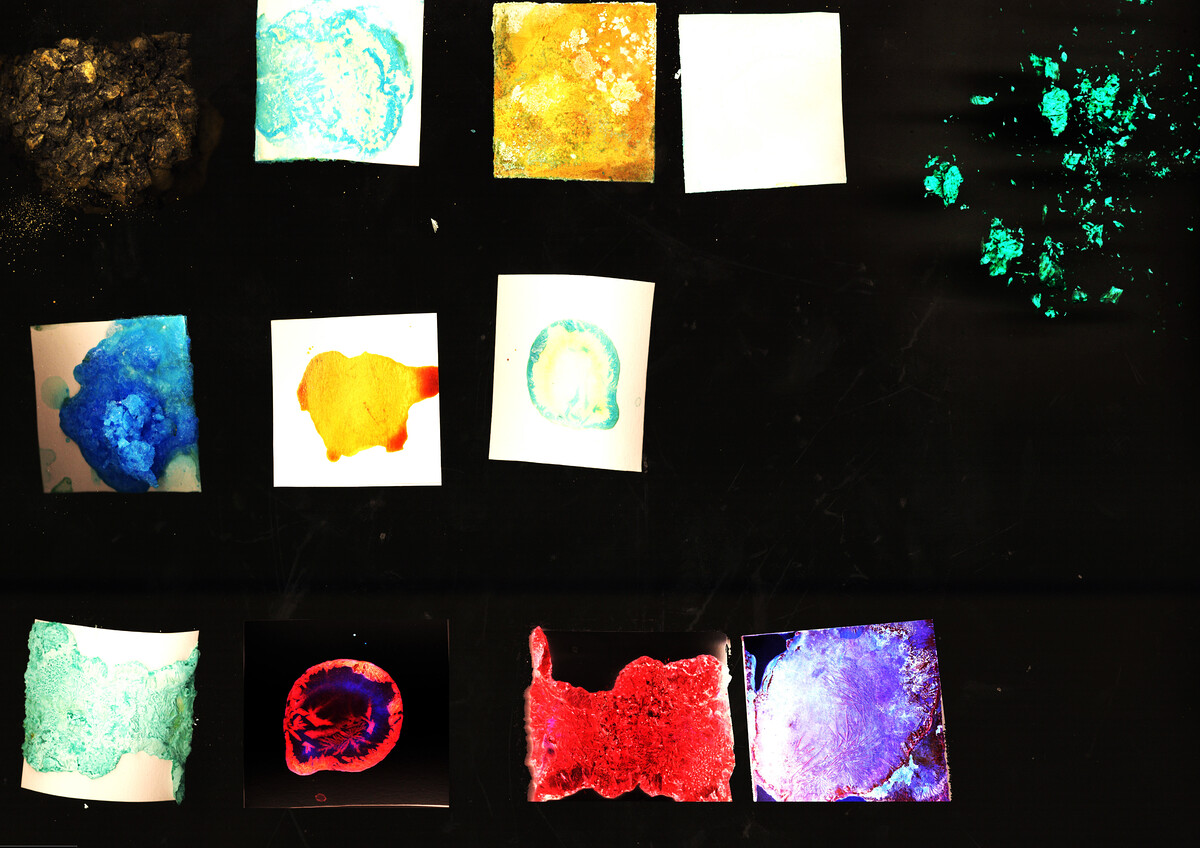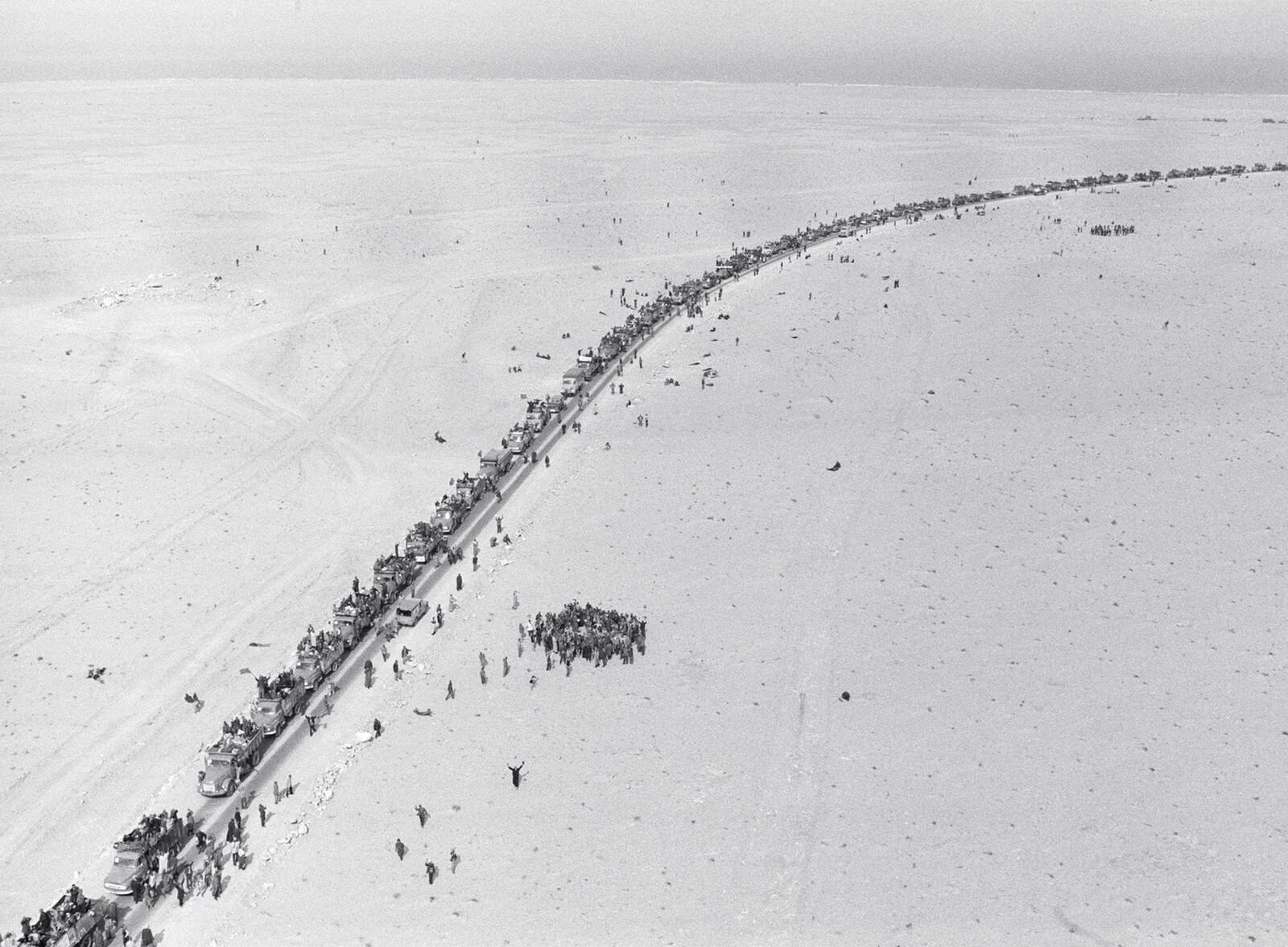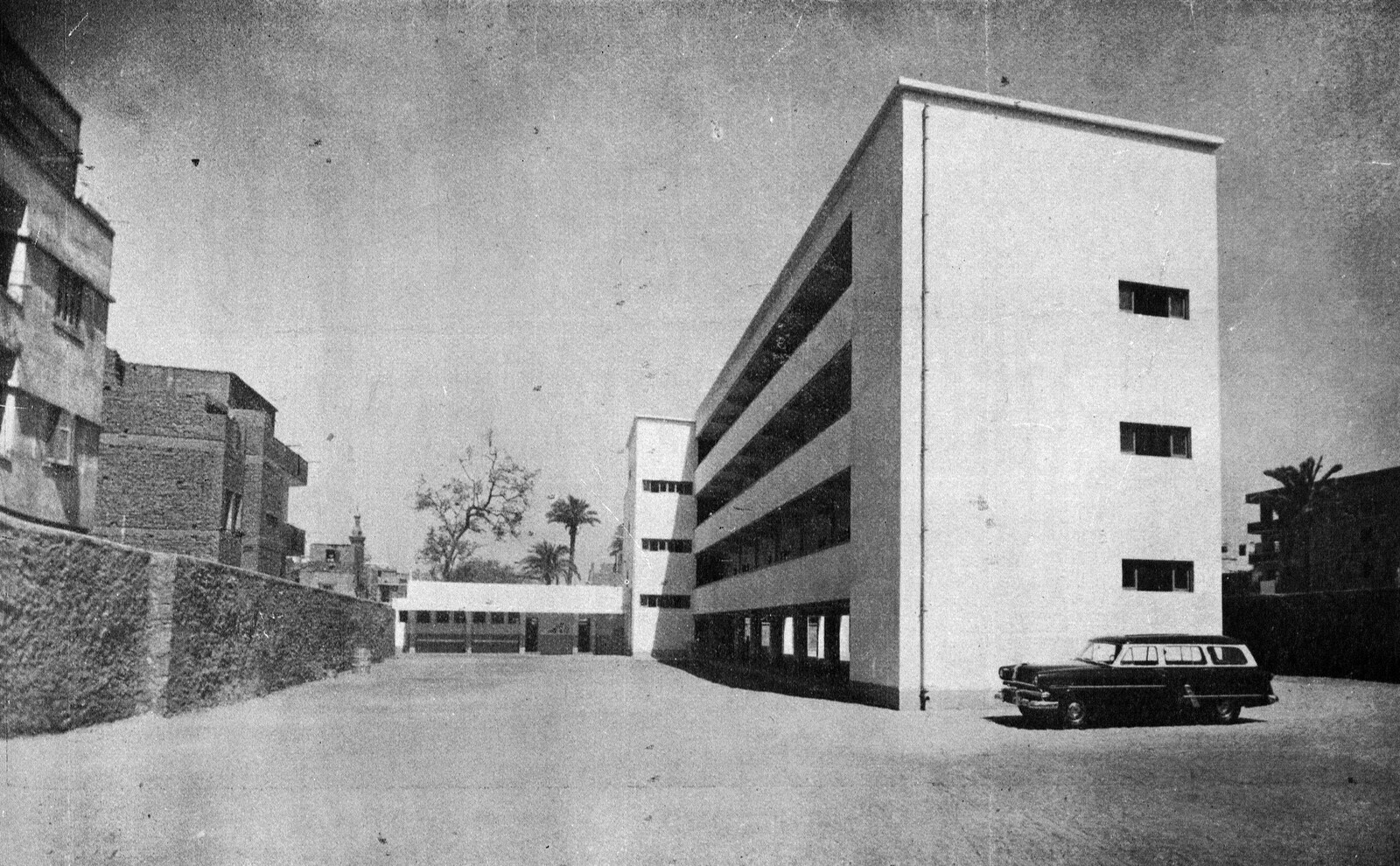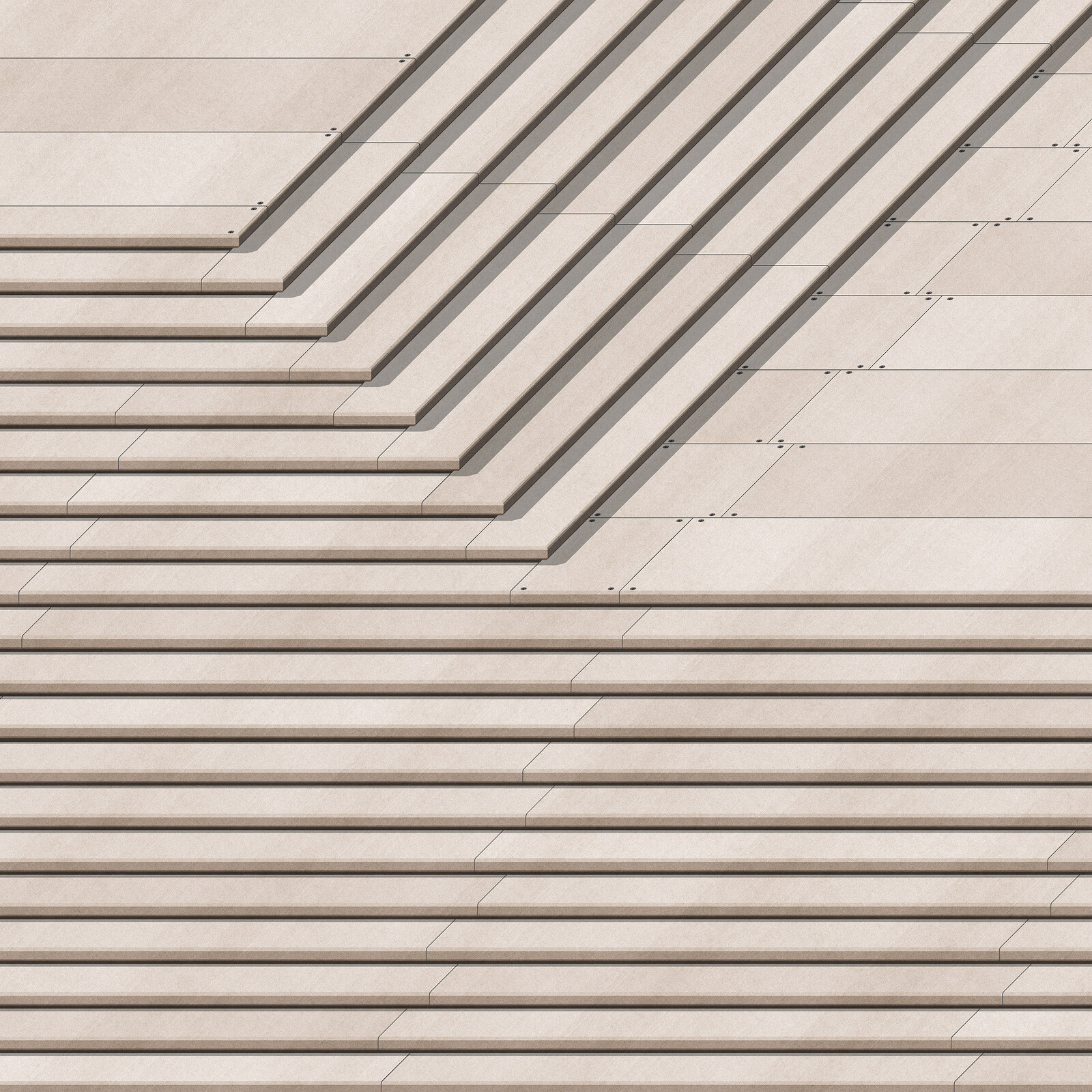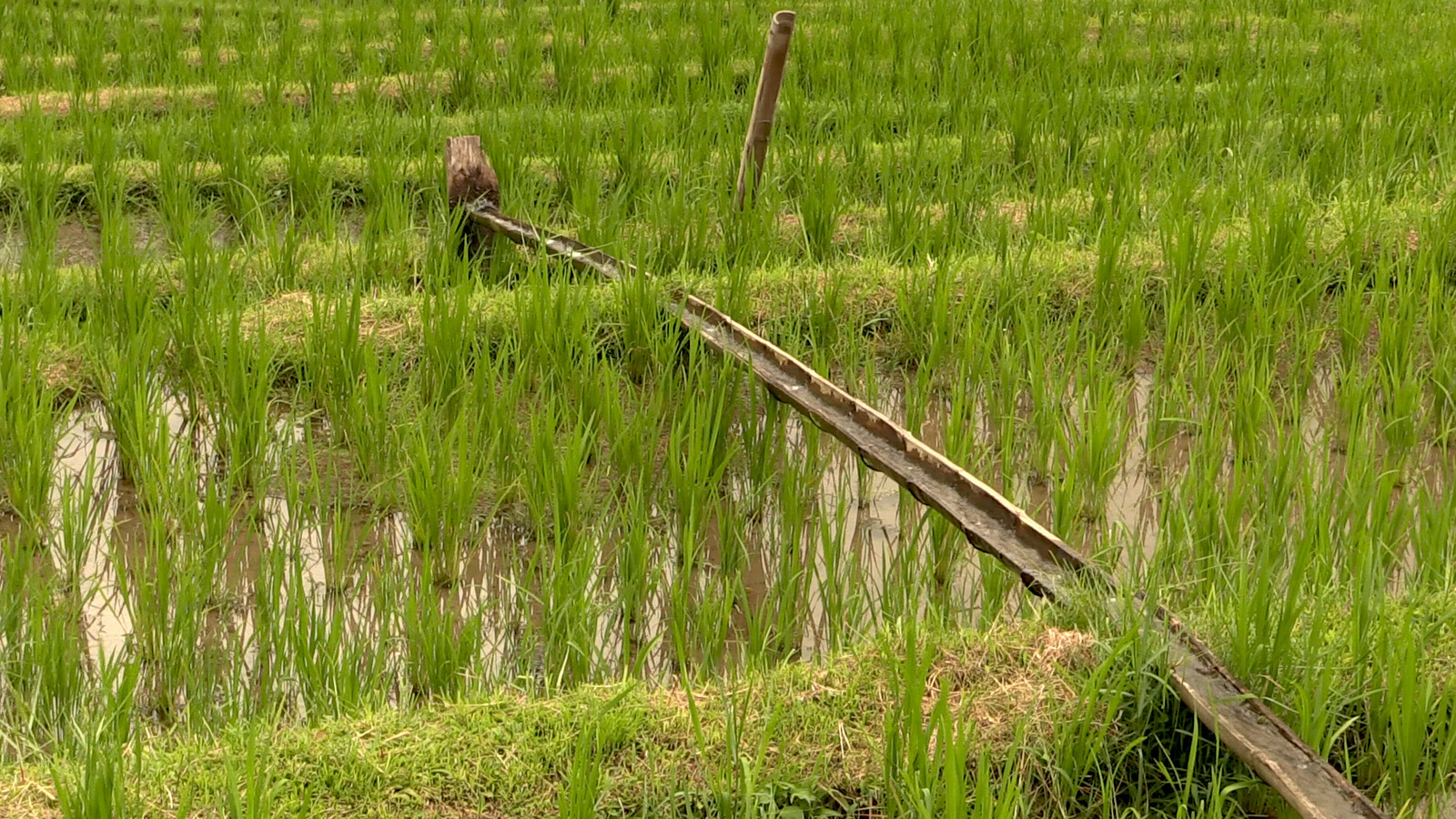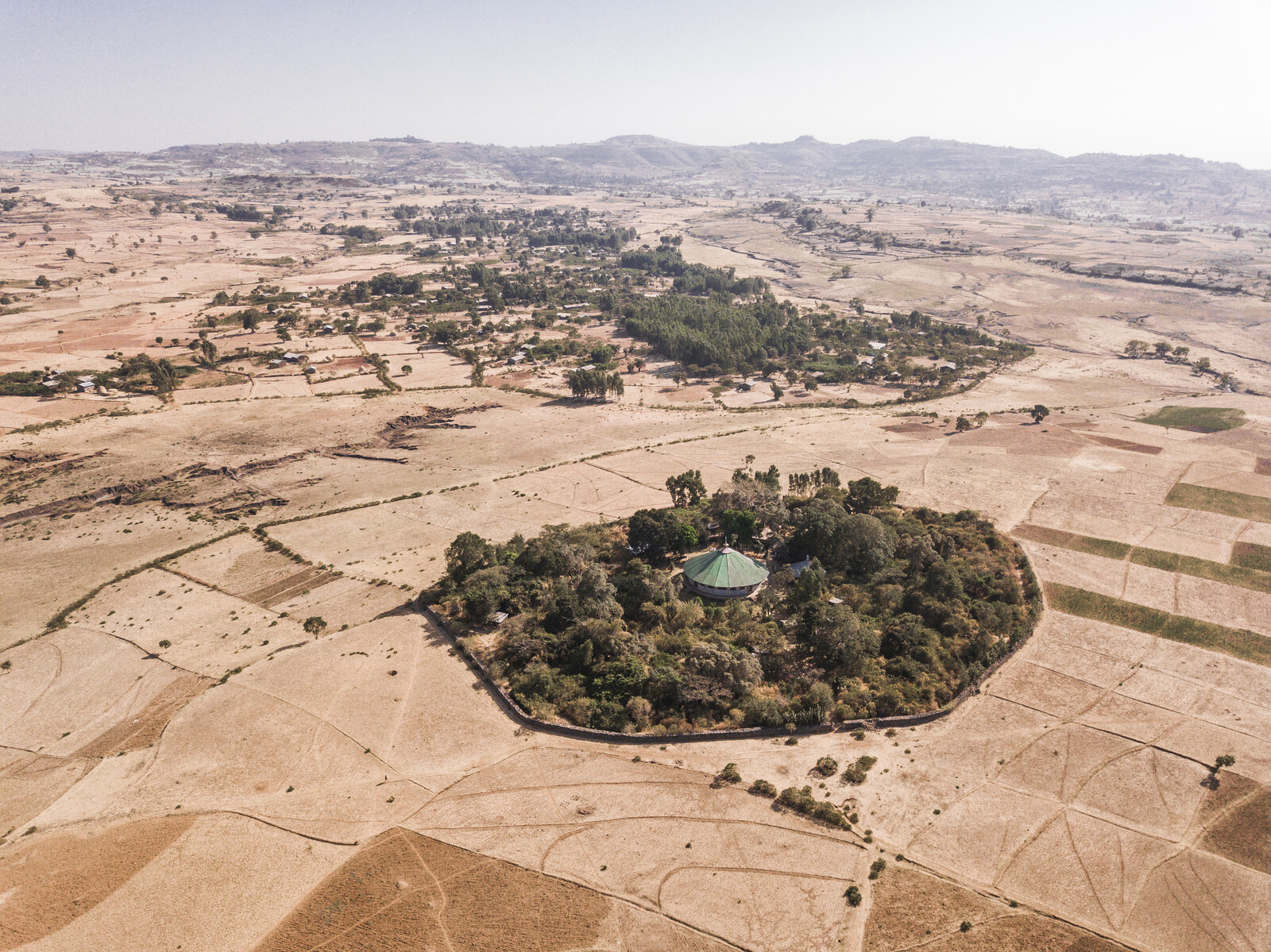In Johannesburg, spaces are divided with walls of varying thicknesses, sizes, gradients, and varying degrees of opacity. Physical walls and dividing infrastructures include golf courses, mine dumps, cemeteries, and retail conglomerates, often intended as hostile expanses; appendages to their adjacent hosts. These dividing lines separates here and there, this and that, us and them. Buffers and walls are tangibly divisive mechanisms between races, ethnicities, faiths, and belief systems, economic brackets, and ideologies. High above, a drone’s eye view captures glimpses of people and goods clustering, shifting, and traversing the expansive left-over territories at the seams of the city. Yet there are always moments of suspension on the boundary.
Ritual and residue create a new landscape on the host territory; the in-between becomes inhabited in the photograph, occupied both in an instant and forever. The border or fuzzy line offers political quarantine as a space itself, escaping the rules of its bordering zones. All sorts of new practices, languages, and other strange things emerge here. And apart from the gaze of some nosey celestial being, these phenomena remain largely unrecognized as sites of production for context-specific mutants of cultures, ecologies, and political arrangements. Mine dumps, originally used as a divisive urban tool—massive mountains of toxic separation between economically-suppressed races—have become pedestrian thoroughfares for children, sites for illegal mining, and a place to conduct baptisms.
The occupation of the line can reverse the role of host and parasite. While these practices are informed by a set of phenomena of different attributes lying on either side of the line, the occupied in-between becomes host to new functions of the territories outside. The give and take, the gentle and violent forms of “hustle for the [surplus ground]” remains relentless.1 Here, in visceral pursuit of this oscillating membrane of transaction is a shifting geography, a conflated, spatialized crunch of need and ever more unsecured resources.
Bodies, entities, and people who are able to circumvent these divides place themselves as points in fields and are able to define themselves through much more open means. Entities which do not confine (and thereby define) themselves by walls allow themselves to see and understand more myriad aspects and perspectives of the city. If we understand that the city is defined and understood very differently by and for different groups of people through the lenses of their walls, then by extension, new readings of the city and new understandings may be a first step to understanding and engaging with other Johannesburgs.
1. Deep Level Mines (-1981.2 meters)
The cleverest among [the Zama Zamas] exploited the mining house’s operations. When the legal miners detonated explosives at the end of their shifts, the dust was given four hours to settle before the next shift arrived to remove all the rocks containing gold.
The Zama Zamas covered their faces with wet cloths and accessed the blast site after two hours to remove the gold-bearing rock.
They ground, washed, separated, and burnt their loot in the tunnels. They used ingenious methods to smuggle the pure gold out of the mines… Some filled condoms with gold and asked female miners to insert them in their vaginas when they went to the surface.2
Gold is the grand irony of Johannesburg. When gold was discovered in the region by George Harrison in 1886, the world’s largest ever gold-rush began. It did not take long for fortune-seekers from across the world to arrive in the area, and the sleepy stretch of leftover farmland was quickly transformed into a settlement. Since then, Johannesburg has always attracted people looking for better prospects, even up until today. But the discovery of gold that has catalyzed its development was also used as a device to deepen ethnic divides. During apartheid, migrant and black labor forces were exploited in the mines, and the massive mountains of radioactive waste yellow earth (ferrous and other chemical compounds from explosive reactions) excavated from the underground in search of the precious metal, were used to separate and contain different race groups.
Today, large areas of the city are hollow underground, and most of the accessible gold is gone—leaving an extensive underground network of tunnels in its wake. Miners who scavenge on the leftover gold underground are known as Zama Zamas, which translates to “try and try” or “try your luck!” These people enter the underground city, often paying exorbitant bribes to do so, and dwell there for months at a time. The miners are “invisible citizens of an almost surreal, subterranean state.”3 Their skin turns grey, their lungs polluted—their very existence is a feat of persistence against the extreme conditions of being away from natural light for months on end and constantly inhaling dust.
Naturally, whole subterranean economies develop in response to their needs to survive, with prices getting steeper the deeper underground the miners are. Boats Botes, a security chief who has protected mining operations for thirty years, established that prices of food sold to the Zama Zamas, from loaves of white bread and jars of peanut butter to bottles of brandy and loose cigarettes, cost nearly ten times more when delivered underground as they do on the surface.4
This expansive set of tunnels, which arguably takes up more volume than the city itself, has been largely forgotten. Eroded out of sight, it has become shrouded by edifices, highways, and Highveld grasses. Yet this underground city continues to find new inhabitants, drawing the most vulnerable in the city above; a reminder that the gold that built the city still allures desperation.
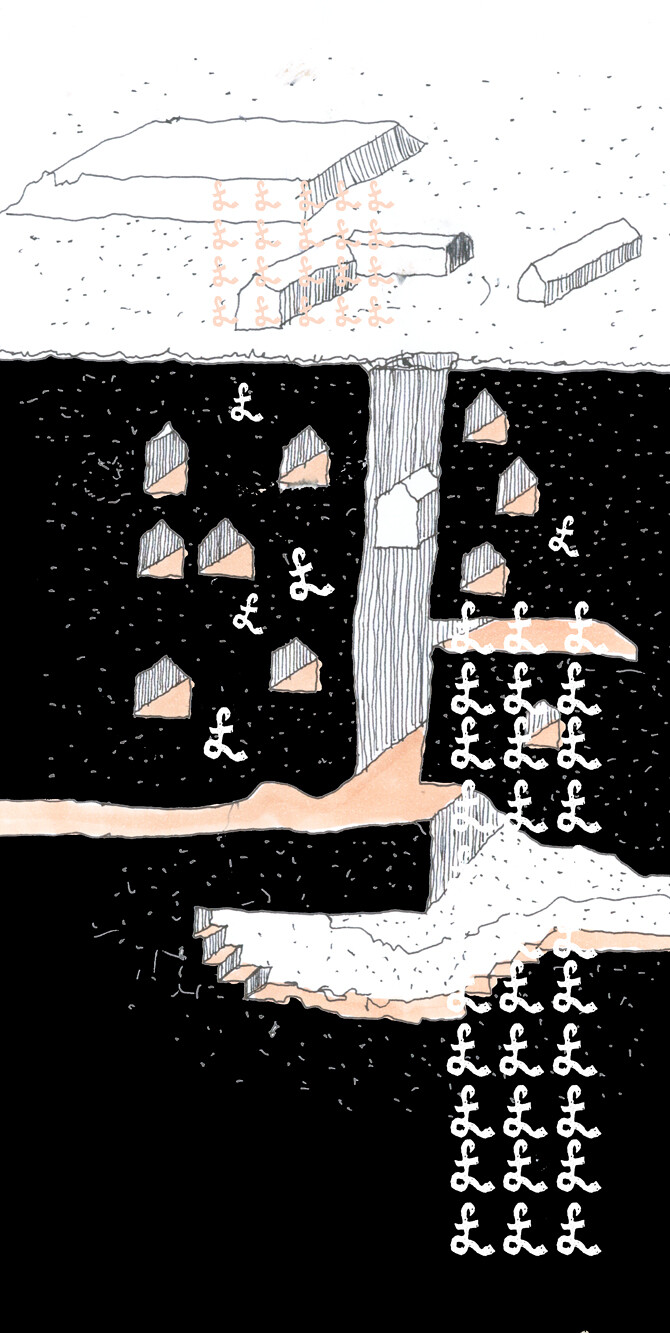

Zama Zamas, or illegal miners, participate in a subverted economy; where the price of commodities underground exponentially appreciate value, due to the adversity against their attainability. Drawing: Sarah de Villiers.
2. Disappearing houses/sinking sand (-282 meters)
An early morning on Delagoa colliery in the Witbank area, a man goes in search of coal. The local community of KwaGuqa live near the abandoned mine. David Ndlovu, from KwaGuqa, is one of the many who have fallen victim to the abandoned mines in the area. In 1999, he was walking to work along one of the many footpaths which criss-cross the mine when a sinkhole collapsed beneath him. As he sank into the ground, he was badly burned up to his waist by the coal, which has been burning underground since the mine was decommissioned in the 1950s…5
Anna’s breathing has been badly affected and she relies on medicated breathing apparatus to relieve the tension in her lungs. The family suffer with sinus problems and constantly take antihistamine pills to relieve the symptoms. Anna’s grandson often wakes up with a bleeding nose and sleeps with a steam machine in his room to clean the air. Black dust is a constant problem. The value of the property has also drastically reduced. They had plans to build houses on the land. Soon after building commenced these plans were halted due to the foundations becoming saturated with acid mine drainage…6
In the middle of the night on August 3, 1964, a massive sinkhole swallowed a house in the mining village of Blyvooruitzicht, 50 miles west of Johannesburg. Six people were sleeping inside the home, and the hole was so deep that no trace of the family was ever recovered…7
[Residents don’t realize] it comes during the night… People can wake up and the section [of the township] is not there…8
The scenes of architectural abduction and invisible toxic forces that result from Johannesburg’s abandoned gold mines would fit well into pages of a science fiction novel. The aftereffects of toxic mining processes are becoming visible a century after the mining commenced. Many of the mines were left unmarked after their closure, and it is not uncommon for structures to be swallowed into the hollow earth. Groundwater fills the shafts, which after mingling with metal sulfides in the rock and oxidizes, turns a brilliant orange and renders it potently acidic. Rising up through the shafts, its color is an eerie reminder of the mining, sometimes surfacing in areas that were never even recorded as formal mines. This so-called acid mine drainage (AMD) spills into rivers, streams, and other groundwater sources, poisoning drinking water and threatening the Cradle of Humankind, “the UNESCO World Heritage site that is home to some of the oldest known hominin fossils in the world.”9 Much of this unstable, sinkhole area is inhabited by informal settlers. Although much of the gold is long gone, it still haunts the poorest citizens of the city.
3. Rituals on Man-made Mountain (+92 meters)
The uniform of the John Masowe churches consists of white gowns for both men and women. They worship without shoes, belts, watches, and cell-phones on them as this is viewed as interfering with the descending of the Holy Spirit. The many different Masowe groups are mostly populated by Zimbabwean migrants although often times, other nationalities do come to seek help from the [priests].
A place of worship cannot simply be chosen out of the available land. The exact location needs to be revealed by the Holy Spirit through [priests]. After the Holy Spirit has revealed an appropriate place, the performance of sacralization rituals involves the marking and spiritual separation of the sacred from the profane land. There is a general belief among respondents that the bush is an abode of evil spirits that the groups need to get rid of. Usually the first step involves a night vigil to spiritually claim and take over the space from contrary spirits. As one member said, “If there is something wrong in this place we will definitely know through the spirit. We pray and sprinkle water around to cleanse the place.10
Along what is called the “gold reef,” the seam of land running north-south in Johannesburg that contains all its gold, mountains of incandescent mine waste stand (and erode) as monumental in scale compared to the built form of the city. But zooming in on these dust mountains reveals networks of activity. Though they are man-made, they have become entangled in natural processes. The highly toxic chemical wastes seeping from below often surface as iron red or cobalt blue rivers. Surrounding grasses and foliage—some planted when the mines were active to contain the dust, others planted more recently in attempts to remediate the soils—are sprawling and seemingly uninhibited.
The mine dump’s luminescent structure is interrupted by smaller topographies of crevices and walls that have slowly been printed into a geology by an accelerated settling of blasted rock with poisonous by-products of the explosives. The invisible code for composing this landscape came from abrasive industrial processes decades ago, and their implications are still producing it. Clues in the landscape are often testimony of toxic activity, even when the site is disguised or reconfigured from its prior use as a waste-dump site or an old mine.
Being on the mine dump often feels like being in a scene from a sci-fi film. Perhaps it is this otherworldliness and seclusion from the city that attracts ritual activity. Masowe churches often use the mine dumps as sites of ritual sermon and ceremonial prayer. The process of preparing the space for ritual prayer is an exercise in place making:
1) Chase former evil dwellers.
2) Remove dirt.
3) Dig a hole, place salt in it.
4) Add a sheep’s tail to the hole if available. Sheep’s tails act as good amulets against witchcraft.
5) Cover the hole with soil.
6) Draw a circle of hot ashes within the limit of the cleared space.
7) Have three priests gather around it with a bucket of water in the middle.
8) Mix coarse salt in the water.
9) Pray over the water, simultaneously sprinkling it around.
Uitvalgrond is the word used to describe the original piece of triangular ground at the center of eight farms claimed for mining diggings, in 1886 Johannesburg. Uitvalground translates to “surplus ground” in Afrikaans, given by the South African Republic) as a word to describe land left over between farm portions whose perimeters were defined by the distance a Boer farmer could ride in the day from his or her farmstead. Eyal Weizman, Hollow Land: Israel’s Architecture of Occupation (London and New York: Verso, 2007), 184.
“Inventive Zama Zamas not interested much in doing it legally,” Business Day Live, May 15, 2015, ➝.
Dean Hutton, “ZAMAZAMA4LIFE,” 2point8, ➝.
“Inventive Zama Zamas.”
Ilan Godfrey, “Legacy of the Mine,” Osisa, ➝.
Godfrey, “Legacy of the Mine.”
Ryan Lenora Brown, “Built on gold riches, Johannesburg succumbs to sci-fi sinkholes,” Christian Science Monitor, September 9, 2014, ➝.
“‘Satanic’ sinkholes plague Johannesburg: MEC,” Times Live, October 5, 2011, ➝.
“Pollution Reaches Cradle of Mankind,” Rainharvest, January 15, 2011, ➝.
Peter Kankonde Bukasa, Lorena Nunez Carraso, Bettina Malcomess, and Matthew Wilhelm-Solomon, Routes and Rites to the City: Mobility, Diversity and Religious Space in Johannesburg (Johannesburg: African Centre for Migration and Society, 2015).
Conditions is a collaboration between the Sharjah Architecture Triennial and Africa Is a Country, Ajam Media Collective, ArtReview, e-flux architecture, Jadaliyya, and Mada Masr, within the context of its inaugural edition, Rights of Future Generations.
